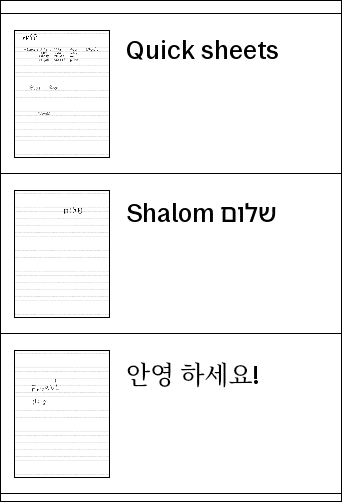Fonts
Several people have asked how to install custom fonts on a reMarkable tablet. This page will explain what I've figured out.
Background
The reMarkable tablets come with a collection of font files pre-installed. The xochitl program (aka the "reMarkable app" running on the tablet) was written specifically to use these fonts, so one thing you absolutely don't want to do is delete these files.
Built-in Fonts
The tablet comes with two font families installed.
Noto is used for most text. Font files are available for just about every human-readable language on the planet.
EB Garamond is used for "fancy" text. It has a limited set of fonts available for languages which don't use latin characters. In particular, none of the languages I searched for (Arabic, Chinese, Hebrew, Japanese, or Korean) have font files available.
Missing Glyphs
One problem you may run into is that the font files don't contain glyphs (the "shapes" you see on the screen for each letter) for every possible character in every possible language. This is especially true for text in languages which don't use "normal" Latin characters.
It is possible to add font files to the tablet. If you do this, and the tablet needs to display those characters, it will use glyphs from those font files rather than showing a generic "box" in place of each character it can't draw.
 Without a Korean font installed
Without a Korean font installed
 With the Noto Serif KR font installed
With the Noto Serif KR font installed
Custom Fonts
The tablet uses the fontconfig library to manage fonts. Any font which fontconfig knows about, will be available for use by xochitl if needed.
The tablet can use .ttf or .otf font files. It might be able to use other formats, I haven't tried. All of the fonts I've needed have been available in one of these two formats.
Font Storage Directory
The fontconfig library is configured with a list of directory names which, if they exist, may contain font files. This list is:
/usr/share/fonts//home/root/.local/share/fonts//home/root/.fonts/
The /usr/share/fonts/ directory is in the OS partition, which means it will be replaced if the OS is upgraded. You can add custom font files here, but I don't recommend it.
The other two directories are under /home/, which is the user data partition. These files will NOT be overwritten when the OS is upgraded.
There is a note in the /etc/fonts/fonts.conf file which says that ~/.fonts is deprecated and will be removed in a future version (not sure if this means a future version of fontconfig or a future version of xochitl), so to be on the safe side, I'm storing the custom font files on my own tablets in the /home/root/.local/share/fonts/ directory.
If it doesn't already exist, you can create this directory using this command:
mkdir -f /home/root/.local/share/fonts
You can create other sub-directories under this if you like, the fc-cache program (below) will scan all sub-directories looking for font files.
Font Cache Directory
Rather than having to scan potentially hundreds of font files in several directories, the fontconfig library uses a database of which fonts exist in which files.
Programs which use the fontconfig library to draw text are able to just use a font name, size, and style, rather than having to manually search through a list of directories and find the actual file which contains the font they want to use. The library also provides substitutions, so if the program asks for a font which isn't installed, the library will use a font which is "close" to what was requested.
This database is stored in the /var/cache/fontconfig/ directory.
Whenever font files are added, updated, or removed from the system, you need to run the fc-cache program to rebuild these cache files.
reMarkable Paper Pro
On the rMPP, the /var/cache/ directory tree is set up to be "non-persistent", meaning that any changes made to it will disappear when the tablet reboots. This is done in two ways:
-
The
/filesystem is mounted read-only. Any attempt to write to any files there will fail, with a "read-only filesystem" error. -
There is an "overlay" filesystem mounted as
/var/cache/. This uses a RAM disk to hold any files which are written to the/var/cache/directory, and makes them "appear" instead of the files which are physically in thevar/cache/directory in the/filesystem (and therefore read-only).
Because of this, fc-cache is able to do its job, however the updated font cache files only exist in the RAM disk. When the tablet reboots, those updated font cache files are gone. So if we want the updated font cache to survive a reboot, we need to do two things:
-
Un-mount the overlay filesystem, so that
/var/cache/is the actualvar/cache/directory on the/filesystem -
Make the
/filesytem writable.
Note that we don't want to leave the / filesytem writable. The reMarkable startup scripts make it read-only for safety reasons, and while there are times you may need to make it read-write for a specific purpose (like updating the font cache files), as a rule it should say read-only in order to prevent accidental damage.
Updating Fonts
Adding Font Files
Upload your custom font files to the /home/root/.local/share/fonts/ directory. You may need to create this if it doesn't already exist.
mkdir -p /home/root/.local/share/fonts
You can then use any SSH file transfer program to do this, I normally use the scp command line client. For example ...
scp filename.ttf root@10.11.99.1:/home/root/.local/share/fonts/
If you need to update or remove any custom font files, update or remove those files now as well.
Rebuild the Font Cache
Any time you add, remove, or update font files, you need to rebuild the font cache files.
-
rMPP: If you want the updated font cache files to be persistent, you'll need to expose the real
/var/cache/directory and make it writable.-
If the
/var/cache/overlay is mounted, un-mount it. This only needs to be done once after the tablet reboots.umount -l /var/cacheNote: this is a lowercase "L", not an uppercase "i" or a digit "one".
-
Make the
/filesystem writable.mount -o remount,rw /
-
-
All tablets: Run this command to rebuild fontconfig's cache files.
fc-cache -fvThe
-foption tells it to rebuild the cache files for directories which were previously cached.The
-voption tells the command to show more information about what it's doing. Specifically, it shows you each directory it's processing.# fc-cache -fv /usr/share/fonts: caching, new cache contents: 0 fonts, 1 dirs /usr/share/fonts/ttf: caching, new cache contents: 0 fonts, 2 dirs /usr/share/fonts/ttf/ebgaramond: caching, new cache contents: 12 fonts, 0 dirs /usr/share/fonts/ttf/noto: caching, new cache contents: 13 fonts, 0 dirs /home/root/.local/share/fonts: caching, new cache contents: 0 fonts, 1 dirs /home/root/.local/share/fonts/NotoSerifKRFont: caching, new cache contents: 7 fonts, 0 dirs /home/root/.fonts: skipping, no such directory /usr/share/fonts/ttf: skipping, looped directory detected /home/root/.local/share/fonts/NotoSerifKRFont: skipping, looped directory detected /usr/share/fonts/ttf/ebgaramond: skipping, looped directory detected /usr/share/fonts/ttf/noto: skipping, looped directory detected /var/cache/fontconfig: cleaning cache directory /home/root/.cache/fontconfig: not cleaning non-existent cache directory /home/root/.fontconfig: not cleaning non-existent cache directory fc-cache: succeededThe "looped directory" messages are harmless, they just mean that
fc-cachehas already scanned that directory and is refusing to scan it a second time. -
rMPP: Make the
/filesystem read-only again.mount -o remount,ro /
Restart xochitl
After rebuilding the font cache, you need to restart xochitl. This is because it doesn't automatically re-read the font cache files every time they get rebuilt, it only reads them once when it starts up.
systemctl restart xochitl.service
If you're watching the tablet's display, you'll see the screen go black and then see the "loading" message while the software starts up.
Once this is done, the new fonts will be available as needed.
Renaming Notebooks
You can also change notebooks' "display names" to include characters in these alternate fonts.

However. You can't do this using xochitl (the software running on the tablet itself), because neither the on-screen keyboard, nor the "type folio", have the ability to type arbitrary characters in languages other than the ones supported by the software.
A user on Reddit reports that the reMarkable desktop and/or mobile apps are able to rename folders and documents to include emoji in the title, and that those emoji carried over to the tablet. I can't use their desktop or mobile apps because I don't use the reMarkable cloud, so I have no way to verify this, however it does make sense - if the computer, tablet, or phone where the app is running provides a keyboard with full unicode support, it can "type" unicode characters (such as emoji).
They also reported that, even though they have an rMPP with a colour screen, the emoji they were using appeared in colour on the computer, but in greyscale on the tablet. I suspect this is because their computer had a font file containing colour glyphs for those emoji, but the tablet has a font file with greyscale glyphs.
If this is also not an option for you, the other option is to edit the document's metadata file.
⚠️ Be very careful.
Making the wrong kind of typo here can cause problems. At the very least, it can make the document "not work" on the tablet, or it's possible that it could crash the software entirely. I don't know, because I've been editing JSON file for 20+ years, and I've always been really careful when working with files directly on the tablet, especially when editing their contents.
If you're not 100% sure what you're doing, PLEASE don't try to do this.
Identify the document's UUID
reMarkable documents are stored in the tablet's filesystem as collections of files, each with a UUID for the name.
ℹ️ UUID
A UUID is a "Universal Unique IDentifier". It's a 128-bit number, normally written using hexdecimal digits. The idea is, every document must have a unique identifier, and the chances of the tablet choosing a UUID which is already being used are very small (technically, it's a one in 2128 chance).
This is because the tablet will allow you to give multiple documents the same "display name", if you really want to so do. (I don't recommend it, there's no obvious way to tell which document is which on the tablet's display - unless they have different numbers of pages or something.)
You will need the UUID in order to identify which file to edit. What I normally do is this:
-
In the tablet's UI, rename the document to something unique. (I like to use
xyzzyfor this, but use whatever you like. It just needs to be unique across all documents in your tablet.) -
In the tablet, search the
UUID.metadatafiles to find the one containing that name.# cd /home/root/.local/share/remarkable/xochitl/ # grep -i 'xyzzy' *.metadata 9cc3f363-8076-4ecc-aeb7-ebddbfeaad8c.metadata: "visibleName": "xyzzy"In this example,
9cc3f363-8076-4ecc-aeb7-ebddbfeaad8cis the document's UUID.
It should only find one file. If it finds more than one, go back and rename the document to something unique and try again.
Edit the UUID.metadata file
There are a few ways to do this.
-
The tablet has
viandnanobuilt in. If you're familiar with one or both of them, you can use them.# cd /home/root/.local/share/remarkable/xochitl/ # nano 9cc3f363-8076-4ecc-aeb7-ebddbfeaad8c.metadata -
You can also download this one file using
scp, edit the file on your computer, and upload it back to the tablet.If you do this, be sure you're using a TEXT EDITOR which can use (and save) files having only LF (aka
\n) characters at the ends of the lines. DO NOT use a "word processor". You must, Must, MUST make sure that the file you upload back to the tablet contains nothing but JSON.
However you edit the file, you're going to need to either use an editor which allows you to type Unicode characters (vi and nano on the tablet do not), or you're going to have to manually look up the Unicode "code point" values for each character. (This is what I did, to make the Korean and Hebrew filenames you see in the examples on this page.)
Assuming you're entering the Unicode code points directly, you'll need to encode each non-latin character as \uXXXX, where XXXX is the code point number in exactly four hexadecimal digits. For example ...
| Language | String | Encoded |
|---|---|---|
| Korean | 안영 하세요! | \uC548\uC601 \uD558\uC138\uC694! |
| Hebrew | Shalom שלום | Shalom \u05E9\u05DC\u05D5\u05DD |
Before you save your changes ...
-
Be aware that some languages (such as Hebrew or Arabic) are written as "right-to-left" text. The tablet will show strings of these characters in right-to-left on the display. Be careful to enter their code point values in right-to-left order as well.
For example,
שis "ש". It's the first character in the string in the file, but it appears at the far right when the word is shown on the screen. -
DO NOT edit anything other than the value on the
"visibleName"line. -
MAKE SURE the string has double-quotes before and after the title.
-
If the line you edited DID HAVE a comma at the end, don't remove it.
-
If the line you edited DID NOT HAVE a comma at the end, don't add one.
{ "createdTime": "1728093402780", "lastModified": "1728094480054", "lastOpened": "1728095240368", "lastOpenedPage": 0, "parent": "", "pinned": false, "type": "DocumentType", "visibleName": "Shalom \u05E9\u05DC\u05D5\u05DD" }ℹ️ Different file formats
This example is from an rM2 running 3.14.1.9. Different versions of the reMarkable software may include more, less, or "other" keys than the ones shown here.
As long as the
"visibleName"line is the only one you edit, you should be fine.
Once you're sure that the file is correct, save your changes.
Restart xochitl
After renaming a document by hand, you need to restart xochitl to make it re-read the documents' names from the disk.
systemctl restart xochitl.service
Assuming you did everything correctly, you should see the document's new name in the file browser.